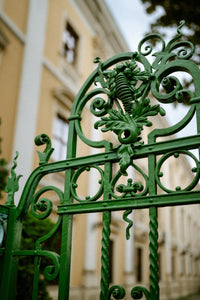Wrought iron has been around forever, and for good reason. It’s strong, it’s classic, and let’s be honest, it just looks good. Whether it’s on handrails, gates, or decorative pieces, there’s something about wrought iron that never goes out of style.
I’ve been working with wrought iron for years now, and over time, you really get to know the good, the bad, and everything in between. So in this article, I want to break down the top five advantages and disadvantages of using wrought iron, especially when it comes to railings, handrails, and gates. If you're thinking about upgrading or replacing some features in your home, this should help you get a clearer picture of what to expect and maybe even learn something new along the way. Let’s get right into it.
Advantages of Wrought Iron
1. Exceptional Strength and Durability
Wrought iron is built to last. It can handle heavy use, pressure, and even accidental impacts without bending or breaking, something softer metals or wood can’t always promise. This kind of strength makes it a perfect fit for gates, especially those exposed to the elements or regular opening and closing. A strong gate doesn’t just hold up, it gives peace of mind.
I’ve seen wrought iron gates that were installed decades ago and still function like the day they were made. That’s the kind of quality that makes you proud to work with a material like this.
2. Customizable and Ornate Designs
One of the reasons people fall in love with wrought iron is its versatility in design. It can be shaped into scrolls, twists, leaves, clean lines; whatever suits the style of the space. This makes it a favorite for handrails, where a simple functional element can become a design feature. Whether you’re aiming for something vintage or minimalist and modern, wrought iron adapts beautifully.
3. Long Lifespan with Proper Maintenance
With a little upkeep, mainly preventing rust and giving it the occasional paint touch-up, wrought iron can last for generations. This makes it a smart, long-term choice for railings, especially those exposed to outdoor conditions. Once installed, you’re not thinking about replacements or repairs for a very, very long time.
4. Enhanced Security
Wrought iron isn’t just beautiful, it’s tough. A properly installed wrought iron gate or railing acts as a serious deterrent for anyone thinking about entering where they shouldn’t. It’s hard to tamper with, hard to cut through, and stands its ground. That’s why clients often choose it for properties where safety is just as important as style.
5. Timeless Aesthetic Appeal
There’s something about wrought iron that just works, no matter the architecture. Whether you’re walking up a staircase lined with a decorative handrail, or driving through a classic wrought iron gate, it adds charm and elegance. And yes, it can boost curb appeal and property value too.
I’ve always believed that good design shouldn’t fade with trends, and that’s why I love working with wrought iron. You know it’ll look just as good 20 years from now as it does today.
Disadvantages of Wrought Iron
You know what they say: what goes up must come down. And while I love everything about working with wrought iron, the truth is, no material is perfect. No matter what you choose or how much you invest: your time, your money, or both, there are still a few downsides to keep in mind.
We at SI Handrails believe in full transparency, especially with something we care about as much as wrought iron. So here are the top five disadvantages you should know before diving in.
1. Susceptibility to Rust
Wrought iron and moisture don’t get along too well. If left untreated, it will start to rust, especially in humid climates or near the coast. This is especially important to consider for gates, which are often fully exposed to rain and morning dew. Without proper protection (like rust-resistant paint or powder coating), you’ll find yourself dealing with corrosion over time.
I’ve replaced beautiful old gates that could’ve lasted longer if someone had just taken the time to seal them properly. It’s a small effort that goes a long way.
2. Higher Initial Cost
Wrought iron isn’t the cheapest option out there. Between the material itself and the skilled labor it takes to shape and install it, the cost can be a bit of a shock, especially when compared to vinyl or wood. This can be a sticking point when planning something more extensive like a full railing system.
But in my experience, that higher upfront investment tends to pay off in the long run, both in looks and lifespan.
3. Regular Maintenance Requirements
To keep it looking its best, wrought iron needs a little attention now and then. Think cleaning, sanding small rust spots, and repainting every few years. For handrails, especially those installed outdoors or on front steps, that means setting aside a little time every so often for upkeep. It’s not overwhelming work, but it’s something to plan for if you’re looking for something completely hands-off.
4. Heavy Weight
Wrought iron is dense, and that means it’s heavy, both literally and in terms of installation effort. If you're installing a large gate, you’ll need strong hinges and solid posts to support it. For railing sections, that can mean extra structural support or a more involved installation process.
And here’s the thing: all that extra support usually means extra money, too. More materials, more labor, and sometimes even more tools to get the job done right. It’s one of the reasons why wrought iron tends to sit on the higher end of the budget scale, just like we mentioned earlier.
The upside? That weight is part of what makes it so secure. But it’s worth noting for the sake of logistics (and your back).
5. Limited Flexibility on Uneven Surfaces
Wrought iron doesn’t bend easily, and that’s not always a good thing. If you’re working with a sloped driveway or curved stairway, customizing a gate or railing to fit those angles can be tricky and usually costs more. Pre-fabricated pieces rarely fit just right, so you’ll almost always need custom work.
That’s where experience makes a difference, because making wrought iron fit perfectly isn’t easy, but it’s something we’ve learned to do well over the years.
| ADVANTAGES | HANDRAILS | RAILINGS | GATES | |
| 1. | Strength & Durability | Holds up under daily use | Secure barrier for decks/balconies | Withstands force & weather |
| 2. | Custom Design | Can be detailed to match interior style | Adds architectural flair | Decorative and bold designs |
| 3. | Long Lifespan | Minimal wear indoors | Decades of outdoor use | Reliable long-term entryway |
| 4. | Enhanced Security | Protects entry points like front steps | Extra protection from falls | Hard to break through |
| 5. | Timeless Look | Elegant upgrade to basic stairs | Boosts curb appeal | Classic property entrance |
| DISADVANTAGES | HANDRAILS | RAILINGS | GATES | |
| 1. | Rust Risk | Indoor/Outdoor joints can corrode | Needs sealing or paint | Exposed parts rust fast |
| 2. | High Cost | More costly than wood/metal tubes | Higher install/material cost | Heavy duty parts = High cost |
| 3. | Maintenance | Needs touch-ups and care | Periodic upkeeps | Paint/chips fixes over time |
| 4. | Heavy Weight | Challenging install on stairs | Requires strong anchors | Needs heavy post/hinges |
| 5. | Hard on slopes | Harder to fit curved stairs | Custom work often needed | Tough fit for uneven dryways |
Conclusion
I could talk about wrought iron all day, it’s what I do, and honestly, it’s what I love. If this article gave you a better idea of what wrought iron can bring to your space, or maybe even inspired you to consider adding some custom features, you’re already on the right track.
Feel free to reach out to us or visit our website if you have any questions, want to explore some ideas, or just want to see what we’ve done for others. We’re always happy to help and even happier to create something unique for your home.









